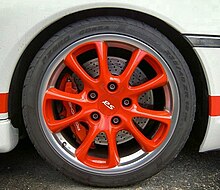Sports tires
Road - legal car and motorcycle tires are referred to as sports tires or semi-slicks , but they are primarily designed for use on racetracks or slalom courses .
features
Sports tires are to be understood as a compromise between normal tires and racing tires that are not street legal . They use the minimum negative profile proportion of 17% prescribed on public roads in Germany and therefore usually have a larger contact area than conventional tires of the same dimension with more negative profile. Often the tread depth of sports tires is also smaller in order to reduce the flexing work of the rubber blocks between the tread lines. In addition, a softer rubber compound is used, which increases traction when accelerating and braking and the static friction when cornering. Sports tires are driven with a lower cold air pressure (usually below 2.0 bar ), but are “pumped up” by around 0.5 to 0.7 bar when they are heated up under heavy loads. Real sports tires should not be confused with sporty road tires, which some manufacturers also refer to as "sports tires". In fact, the main area of application for these tires is on public roads and not on the racetrack; thus the term “sports tires” is often to be understood as a marketing classification.
Strengthen
Especially on dry or slightly damp roads, sports tires can achieve lap times that are roughly between those of slicks and conventional tires. For example, in a test by the magazine sport auto with a standard sports car and sports tires of various makes on the old course connection (without a new chicane at the end of the crossbar) of the Hockenheimring, times in the range of 1:16 minutes were achieved. With slicks it was around 1:14, with the standard tires around 1:18. Due to the lower flexing work and the larger proportion of positive profile, sports tires can withstand high levels of stress for a longer period of time without degrading in performance as quickly and severely as series tires. This makes them the first choice for hobby motorsport enthusiasts who not only drive their vehicle on racetracks, but also want to make the round trip without additional transport options. The use of sports tires is mandatory in some racing series, such as the Caterham Challenge.
weaknesses
Sports tires are inferior to conventional series tires on very damp and wet tracks , even if more recent developments have somewhat reduced this disadvantage. The smaller proportion of the negative profile and the lower profile depth reduce the ability to displace and drain water; Aquaplaning thus occurs at a lower speed. In addition, the boundary area is generally narrower (even on dry roads) ; the loss of liability happens relatively quickly and is therefore hardly controllable for the inexperienced driver. On dry roads, optimum grip is only achieved at a certain operating temperature (60 to 90 ° C, depending on the make) and maximum traction or cornering force is only achieved when there is more or less slip . These properties make the use of sports tires on public roads and the changing weather conditions in Germany a risk of accidents. For this reason, only a few car models have been and are delivered from the factory with such tires, for example the BMW M3 CSL on the Michelin Pilot Sport Cup , the Porsche 911 GT3 RS from the 996 series , the Ferrari 360 CS (both on the Pirelli P Zero Corsa) or the Porsche 911 GT3 of the 997 series . In addition, sports tires are often not sold through the conventional distribution channel, but by the sports departments of the tire manufacturers and sometimes only to holders of racing licenses . The optimal function of the tires is strongly dependent on the correct air pressure and the temperature distribution on the tread; Thus, the driver has to pay close attention to compliance with the manufacturer's recommendations and, if necessary, even adjust the settings of his chassis (more negative camber , harder anti-roll bars ). Due to the higher adhesion on dry roads, the chassis and the brakes are more heavily stressed, so the side inclination (in cars), the "brake diving" and the wear (especially of wheel bearings, suspension parts and brakes) are increased. The better traction also increases the wear on clutch and transmission parts.
trend
Despite the concept-related disadvantages, at the beginning of the new millennium, more and more car manufacturers are equipping their top sporty models with sport tires as standard or on request ex works. The reasons are apparently the increasing interest of amateur sports drivers in race track training since the 1990s (in Germany around the same time as the motorsport boom due to the success of Michael Schumacher ) and the “super tests” of the magazine sport auto ; Among other things, with the lap times of the test cars on the old, small circuit of the Hockenheimring and on the Nordschleife of the Nürburgring . Since these times and the results of other driving dynamics tests are significantly improved through the use of sports tires, manufacturers are increasingly making test vehicles with this equipment available in order to exceed the results of competitors equipped with conventional tires. That is why sport auto has expanded the Supertest to include an additional handling test on wet roads to clarify the usability of the test car tires under these conditions. It emerged from 2006 that newer sports tire types were evidently developed more towards everyday use and that the drop in performance on wet roads compared to conventional, sporty tires is becoming smaller and smaller.
See also
Web links
Individual evidence
- ↑ The BMW M3 CSL in the super test on the Nordschleife and Hockenheimring. sportauto-online.de , accessed on July 15, 2010 .

